Uncategorized
Crypto Daybook Americas: Retail Demand Provides Firm Underpinning to Weaker Markets

By Omkar Godbole (All times ET unless indicated otherwise)
Bitcoin and most major cryptocurrencies are weaker after Chicago Mercantile Exchange, a proxy for institutional activity, denied reports of listing futures tied to XRP and SOL. Traditional markets are also holding their breath for the expected Bank of Japan interest-rate increase on Friday.
Despite BTC’s continued range play above $100,000, retail demand remains robust. Glassnode’s shrimp-Crab cohort, which includes addresses holding up to 10 BTC, have absorbed 1.9 times the newly mined supply last month, totaling over 25,600 BTC. Meanwhile, long-term holders have slowed their spending and profit-taking activities, indicating a cautious, but firm, commitment to their investments.
Still, dropping below $100,000 might prove costly. According to Wintermute’s OTC trader Jake Ostrovskis, that would «frame Monday’s inauguration as a sell-the-news event and the narrative could switch pretty quickly.»
Reports suggest the number of whale wallets holding between 1 million and 10 million XRP has surged to an all-time high of 2,083, signaling increased accumulation and confidence in its future performance.
In the world of innovation, chatter around Bitcoin Synths is gaining traction on X. These synthetic assets allow users to benefit from bitcoin’s price movements without actually owning the cryptocurrency. Bitcoin Synths can be traded or used as collateral in lending protocols, avoiding the complexities associated with wrapped tokens and specialized bridges.
Ethereum layer-2 protocols are also making headlines with record transaction volumes, even as concerns about their capacity nearing limits persist.
On the macroeconomic front, recent data from the Labor Department shows that the «all tenant rent» index, an indicator of shelter inflation in the Consumer Price Index (CPI), rose at a slower pace last quarter. The data suggest that recent worries about inflation may be overdone and the Fed could pivot away from its hawkish forecast, which would be a positive sign for risk assets. Stay alert!
What to Watch
Crypto
Jan. 23: First deadline for SEC decision on NYSE Arca’s proposal to list and trade shares of Grayscale Solana Trust (GSOL), a closed-end trust, as an ETF.
Jan. 25: First deadline for SEC decisions on proposals for four spot solana ETFs: Bitwise Solana ETF, Canary Solana ETF, 21Shares Core Solana ETF and VanEck Solana Trust, which are all sponsored by Cboe BZX Exchange.
Jan. 29: Ice Open Network (ION) mainnet launch.
Feb. 4: MicroStrategy Inc. (MSTR) reports Q4 2024 earnings.
Feb. 4: Pepecoin (PEPE) halving. At block 400,000, the reward will drop to 31,250 pepecoin.
Feb. 5, 3:00 p.m.: Boba Network’s Holocene hard fork network upgrade for its Ethereum-based L2 mainnet.
Macro
Jan. 23, 8:30 a.m.: The U.S. Department of Labor releases the Unemployment Insurance Weekly Claims Report for the week ended Jan. 18.
Initial Jobless Claims Est. 215K vs. Prev. 217K.
Jan. 23, 10:00 a.m.: The National Association of Realtors releases December 2024 U.S. Existing Home Sales report.
Existing Home Sales Est. 4.16M vs. Prev. 4.15M.
Existing Home Sales MoM Prev. 4.8%.
Jan. 23, 4:30 p.m.: The Fed releases the H.4.1 report, the central bank balance sheet, for the week ended Jan. 22.
Total Reserves Prev. $6.83T.
Jan. 23, 6:30 p.m.: Japan’s Ministry of Internal Affairs and Communications releases December 2024’s Consumer Price Index (CPI) report.
Inflation Rate MoM Prev. 0.6%.
Core Inflation Rate YoY Est. 3% vs. Prev. 2.7%.
Inflation Rate YoY Prev. 2.9%.
Jan. 23, 10:00 p.m.: The Bank of Japan (BoJ) releases Statement on Monetary Policy.
Interest Rate Decision Est. 0.5% vs. Prev. 0.25%.
Token Events
Governance votes & calls
Morpho DAO is discussing reducing incentives by 30% across all networks and assets.
Yearn DAO is discussing funding and endorsing a subDAO called Bearn to focus on building and launching products on Berachain.
Frax DAO is discussing a $5 million investment in World Liberty Financial (WLFI), the crypto project backed by the family of U.S. President Donald Trump.
Jan. 23: Livepeer (LPT) is hosting a Core Dev call.
Jan. 24: Arbitrum BoLD’s activation vote deadline. BoLD allows anyone to participate in validation and defend against malicious claims to an Arbitrum chain’s state.
Jan. 24: Hedera (HBAR) is hosting a community call at 11 a.m.
Unlocks
Jan. 31: Optimism (OP) to unlock 2.32% of circulating supply worth $52.9 million.
Jan. 31: Jupiter (JUP) to unlock 41.5% of circulating supply worth $626 million.
Token Launches
Jan. 23: Sky (SKY) is being listed on Bitget.
Jan. 23: Animecoin (ANIME) is launching, with claims starting at 8 a.m. The token will be listed on multiple exchanges including Binance, OKX and KuCoin.
Conferences:
Day 11 of 12: Swiss WEB3FEST Winter Edition 2025 (Zug, Zurich, St. Moritz, Davos)
Day 4 of 5: World Economic Forum Annual Meeting (Davos-Klosters, Switzerland)
Jan. 24-25: Adopting Bitcoin (Cape Town, South Africa)
Jan. 25-26: Catstanbul 2025 (Istanbul). The first community conference for Jupiter, a decentralized exchange (DEX) aggregator built on Solana.
Jan. 30, 12:30 p.m. to 5:00 p.m.: International DeFi Day 2025 (online)
Jan 30-31: Plan B Forum (San Salvador, El Salvador)
Jan. 30 to Feb. 4: The Satoshi Roundtable (Dubai)
Feb. 3: Digital Assets Forum (London)
Feb. 5-6: The 14th Global Blockchain Congress (Dubai)
Feb. 7: Solana APEX (Mexico City)
Feb. 13-14: The 4th Edition of NFT Paris.
Feb. 18-20: Consensus Hong Kong
Feb. 23 to March 2: ETHDenver 2025 (Denver, Colorado)
Token Talk
By Francisco Rodrigues
Azuki, a non-fungible token (NFT) collection, is introducing its Animecoin (ANIME) today on Ethereum and Arbitrum. The token was announced on Jan. 13.
An airdrop will encompass Azuki NFT holders, Hyperliquid HYPE stakes, some Arbitrum ecosystem participants and Kaito yappers.
It will also include certain anime communities and BNB token holders who, between Jan. 17 and Jan. 20, subscribed to Simple Earn with their tokens on Binance.
The debut builds on a growing trend of NFT collections launching their own tokens, a trend that started in 2021 when Bored Ape Yacht Club (BAYC) launched ApeCoin.
Other examples include DeGods’ DUST and Pudgy Penguins’ PENGU tokens, which have a $1.6 billion market capitalization.
Other signs indicate the NFT market is heating up, with Nansen recently pointing out that a Crypto Punk was sold for 170 ETH (around $540,000) while an Azuki was sold for 165 ETH. The Azuki NFT had been bought a month before for 105 ETH.
Derivatives Positioning
The cumulative volume delta indicator reveals that major cryptocurrencies, with the exception of TON, have experienced net selling pressure in the perpetual futures markets over the past 24 hours.
Block flows on Deribit and Paradigm featured long positions in short-dated BTC puts at $100K, $95K and $70K. An entity bought ETH put at $2.9K.
Front-end BTC and ETH calls now traded at par with puts.
Market Movements:
BTC is down 4.1 % from 4 p.m. ET Wednesday to $102,020 (24hrs: -2.71%)
ETH is down 3.85% at $3,206.18 (24hrs: -2.83%)
CoinDesk 20 is down 3.61% to 3,799.21 (24hrs: -3.58%)
CESR Composite Ether Staking Rate is down 15 bps to 3.15%
BTC funding rate is at -0.0019% (-2.08% annualized) on OKX
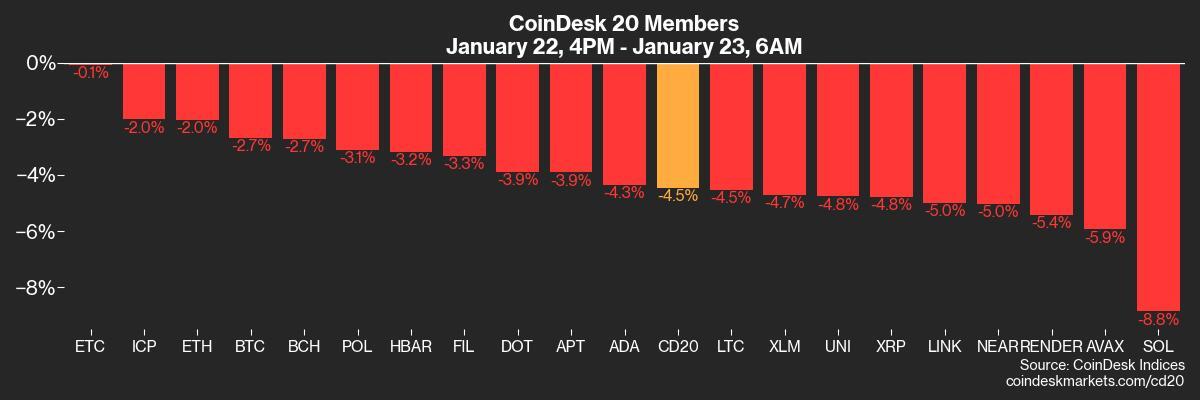
DXY is unchanged at 108.25
Gold is down 0.35% at $2,761.10/oz
Silver is down 0.73% to $30.57/oz
Nikkei 225 closed up 0.79% at 39,958.87
Hang Seng closed down 0.4% at 19,700.56
FTSE is unchanged at 8,538.7
Euro Stoxx 50 is unchangedat 5203.6
DJIA closed +0.3% to 44,156.73
S&P 500 closed +0.61% at 6,086.37
Nasdaq closed +1.28% at 20,009.34
S&P/TSX Composite Index closed +0.12% at 25,311.5
S&P 40 Latin America closed +1.21% at 2,297.32
U.S. 10-year Treasury is up 3 bps at 4.59%
E-mini S&P 500 futures are down 0.19% to 6,109.00
E-mini Nasdaq-100 futures are down 0.56% to 21,876.75
E-mini Dow Jones Industrial Average Index futures are unchaged at 44,384.00
Bitcoin Stats:
BTC Dominance: 58.59
Ethereum to bitcoin ratio: 0.031
Hashrate (seven-day moving average): 781 EH/s
Hashprice (spot): $58.9
Total Fees: 8.5 BTC/ $876,410
CME Futures Open Interest: 188,396 BTC
BTC priced in gold: 37.1 oz
BTC vs gold market cap: 10.56%
Technical Analysis
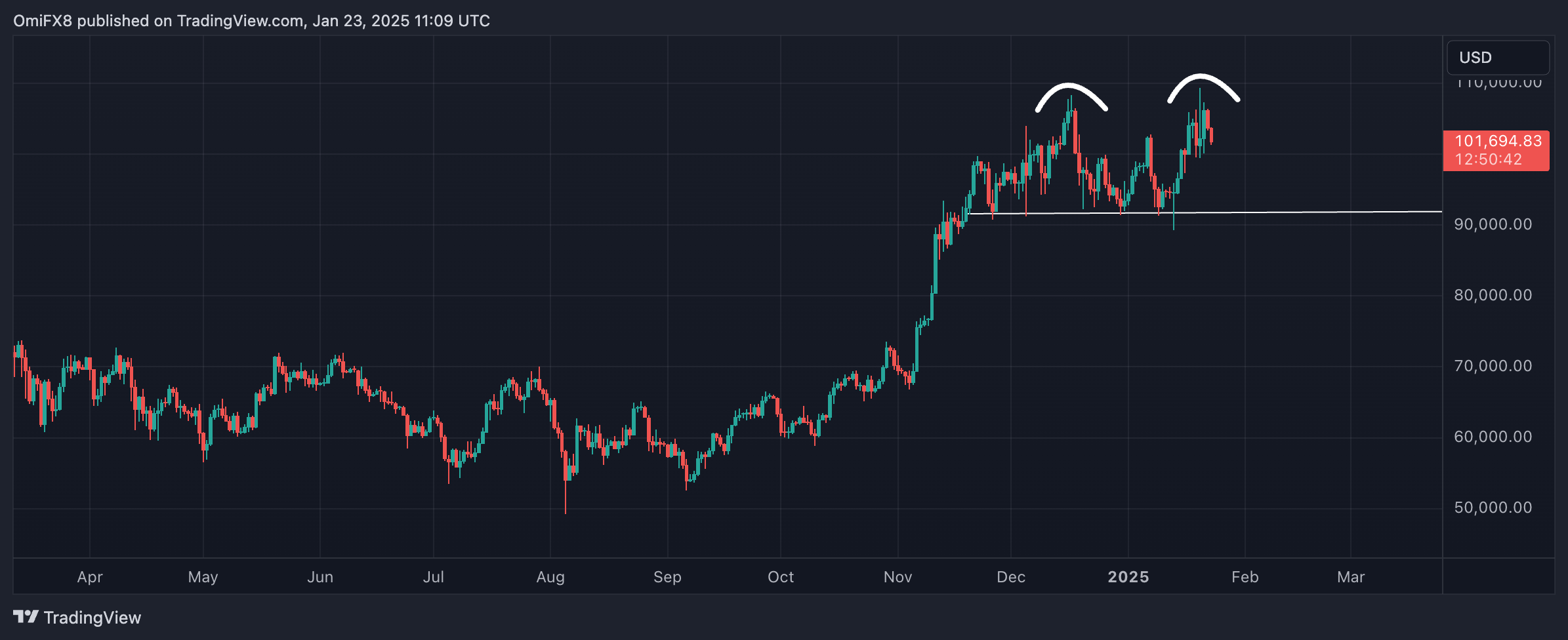
BTC’s retreat from Monday’s high is teasing a formation of a double top bearish reversal pattern.
A move below the horizontal line would confirm the pattern, potentially bringing more chart-led sellers to the market.
Crypto Equities
MicroStrategy (MSTR): closed on Wednesday at $377.31 (-3.03%), down 1.89% at $370.19 in pre-market.
Coinbase Global (COIN): closed at $295.85 (+0.56%), down 2.59% at $288.18 in pre-market.
Galaxy Digital Holdings (GLXY): closed at C$32.81 (+4.99%)
MARA Holdings (MARA): closed at $19.69 (+0.66%), down 2.54% at $19.19 in pre-market.
Riot Platforms (RIOT): closed at $13.14 (+3.14%), down 1.75% at $12.91 in pre-market.
Core Scientific (CORZ): closed at $15.97 (+4.58%%), down 1.63% at $15.71 in pre-market.
CleanSpark (CLSK): closed at $11.14 (+1.64%), down 2.51% at $10.86 in pre-market.
CoinShares Valkyrie Bitcoin Miners ETF (WGMI): closed at $25.53 (+2.24%), up 2.58% at $28.27 in pre-market.
Semler Scientific (SMLR): closed at $62.11 (-4.36%), up 2% at $64.90 in pre-market.
Exodus Movement (EXOD): closed at $41.00 (+2.5%), down 2.07% at $40.15 in pre-market.
ETF Flows
Spot BTC ETFs:
Daily net flow: $248.7 million
Cumulative net flows: $39.23 billion
Total BTC holdings ~ 1.161 million.
Spot ETH ETFs
Daily net flow: $70.7 million
Cumulative net flows: $2.81 billion
Total ETH holdings ~ 3.648 million.
Source: Farside Investors
Overnight Flows
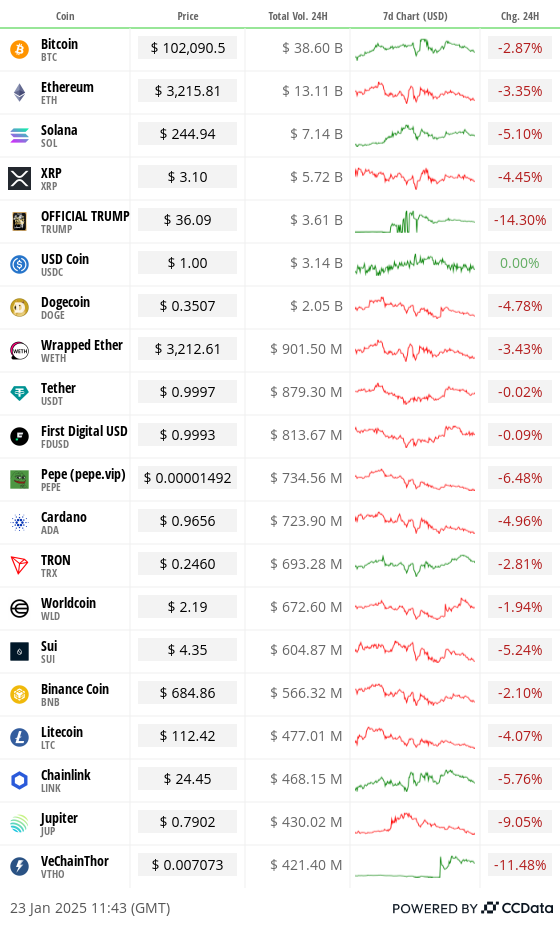
Chart of the Day
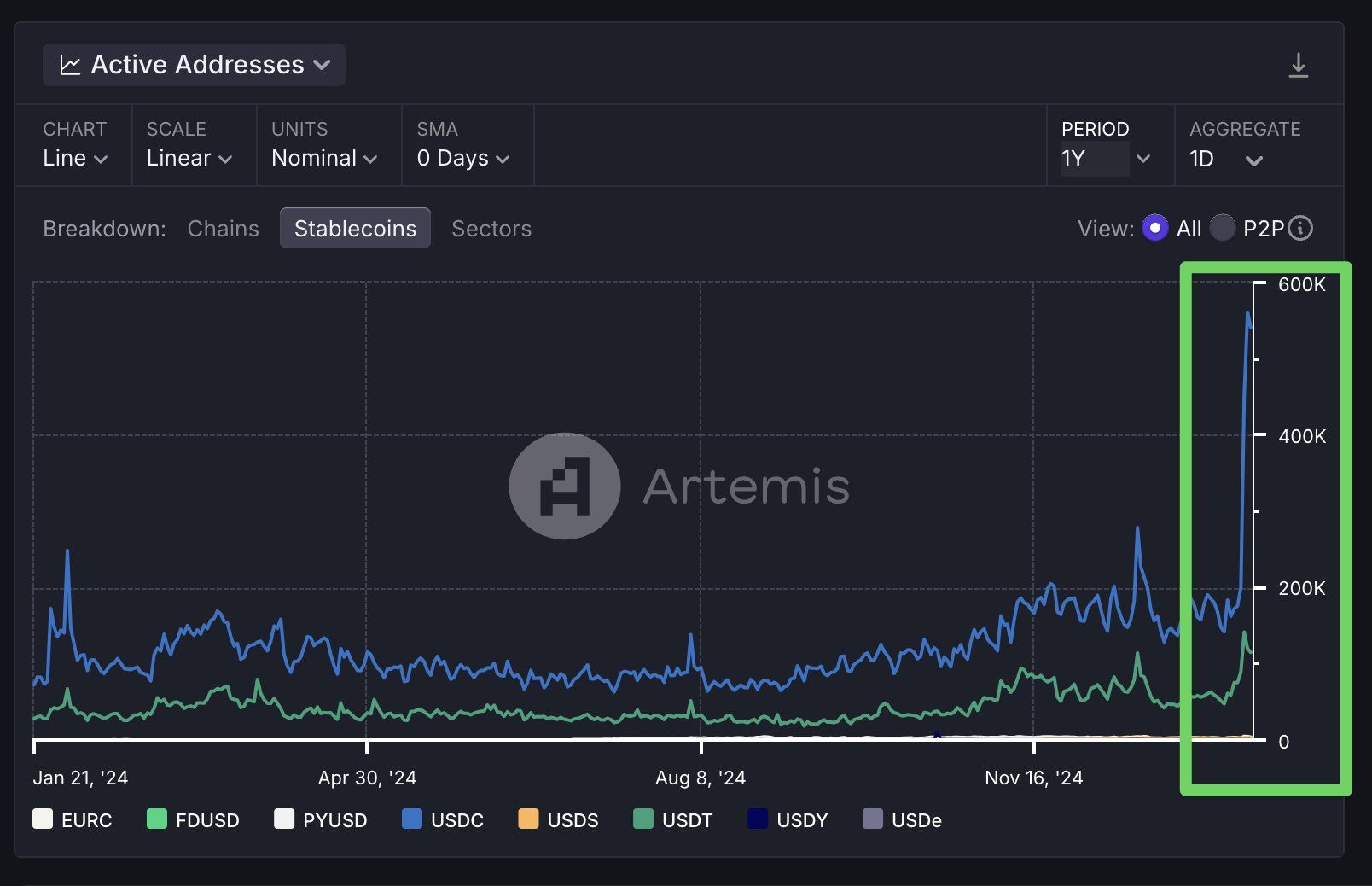
The chart shows a spike in the number of active addresses on Solana.
Addresses holding USDC led the growth as TRUMP token frenzy gripped the market over the weekend.
While You Were Sleeping
Bitcoin Is Like Coiled Spring Nearing Burst of Price Volatility, Key Indicator Suggests (CoinDesk): Bitcoin’s tight 60-day price range suggests impending volatility, according to Glassnode and bullish options activity signals market optimism.
Trump’s CFTC Pick Clears Top Ranks of Key US Crypto Regulator (CoinDesk): Newly appointed CFTC Chair Caroline Pham has overhauled the agency’s leadership. The changes could reshape the CFTC’s role in cryptocurrency oversight.
Bitwise Registers Delaware Entity for Potential Dogecoin ETF (Decrypt): Bitwise Asset Management has registered a statutory trust in Delaware named “Bitwise Dogecoin ETF,” a preparatory step toward potentially filing a Form S-1 with the U.S. Securities and Exchange Commission.
Dollar Treads Water as Trump Tariff Clarity, Central Banks Awaited (Reuters): The dollar held steady as traders awaited clarity on Trump’s tariff plans. Focus is shifting to rate decisions from the Bank of Japan, Fed and ECB.
China Ramps Up Support for Its Stock Markets (The Wall Street Journal): Chinese regulators said state-owned insurers and mutual funds would invest at least 100 billion yuan ($13.7 billion) into the A-shares market. The central bank also pledged to support the stock market.
Davos Hits ‘Peak Pessimism’ on Europe as U.S. Exuberance Rises (Financial Times): U.S. executives at Davos expressed optimism over Donald Trump’s “America First” policies, while their European counterparts voiced pessimism about the potential harm to struggling EU economies from tariffs and regulatory changes.
In the Ether

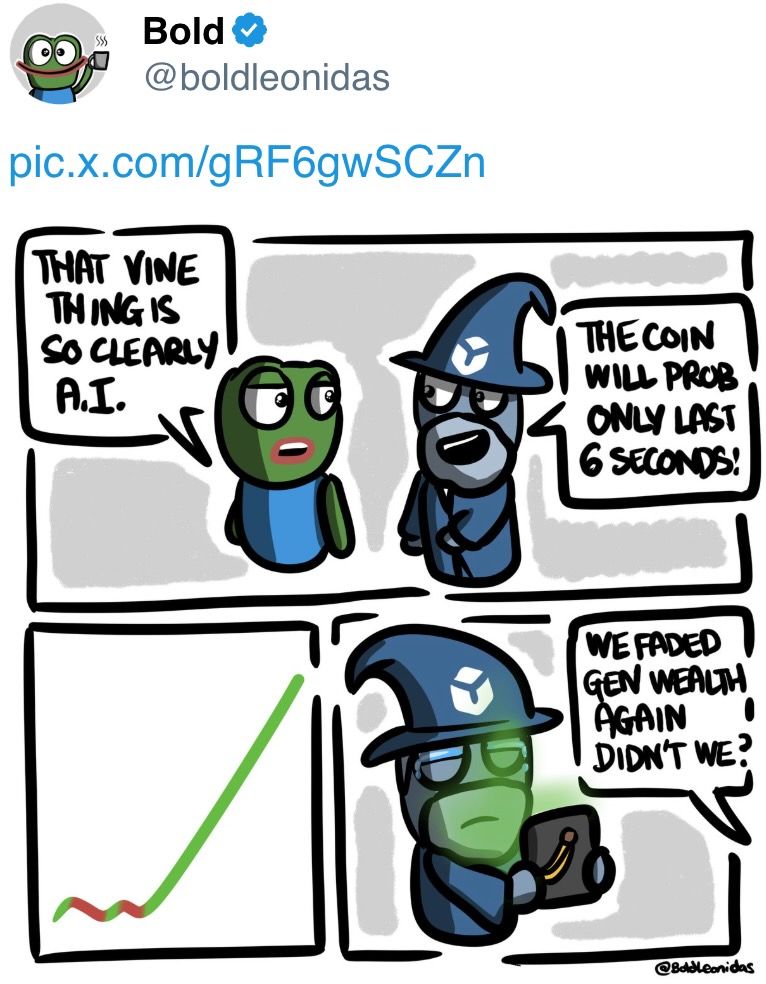
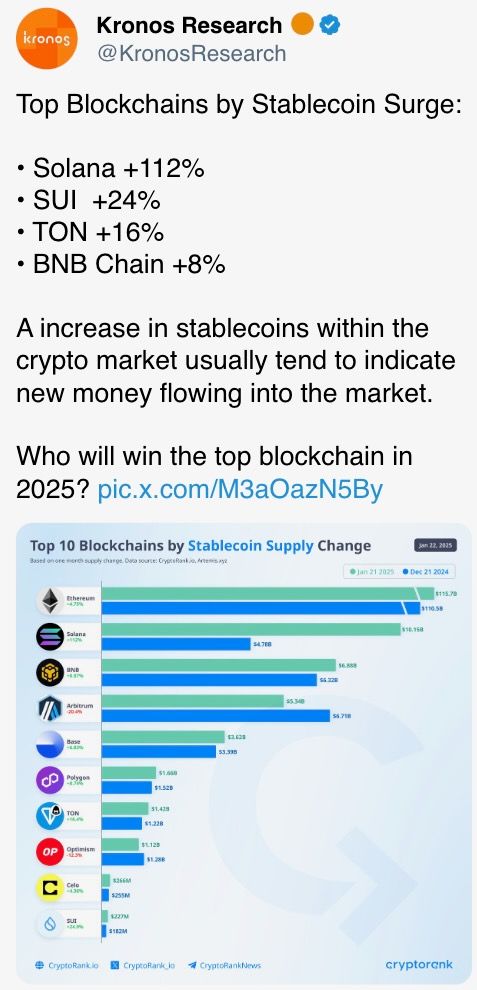
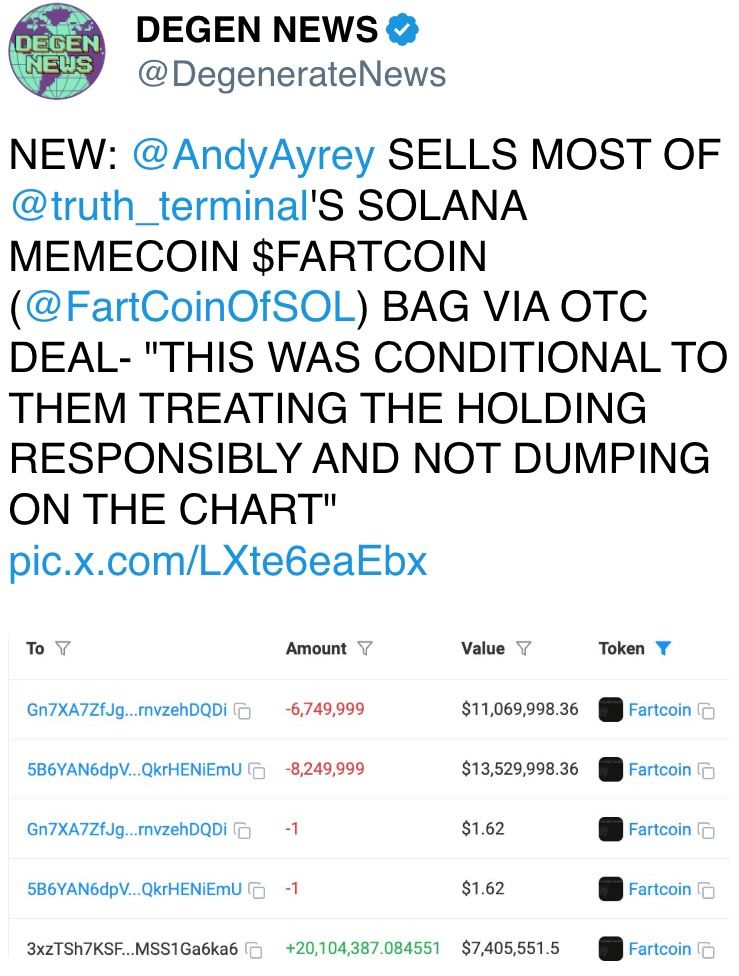

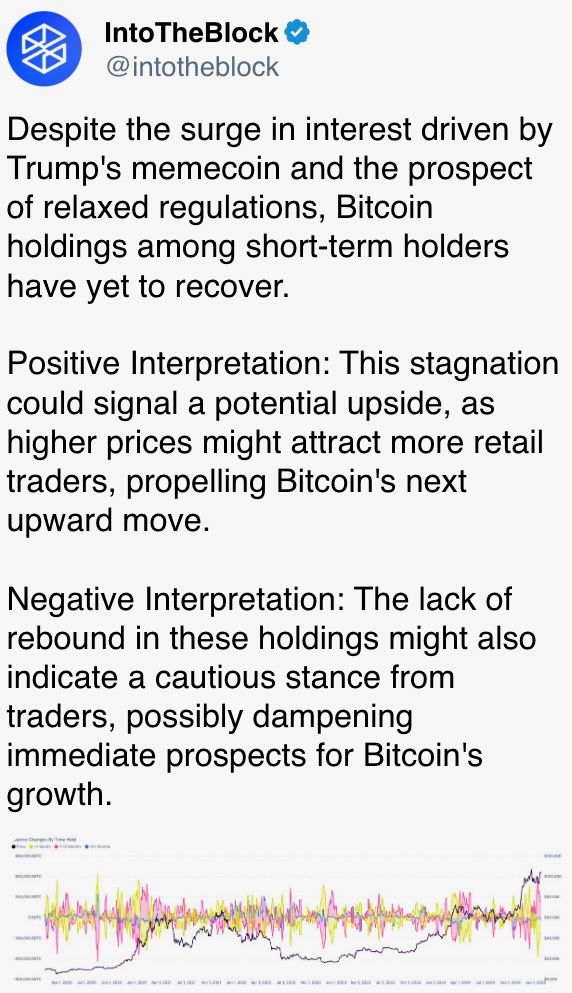
Business
AAVE Sees 64% Flash Crash as DeFi Protocol Endures ‘Largest Stress Test’

The native token of Aave (AAVE), the largest decentralized crypto lending protocol, was caught in the middle of Friday’s crypto flash crash while the protocol proved resilient in a historic liquidation cascade.
The token, trading at around $270 earlier in Friday, nosedived as much as 64% later in the session to touch $100, the lowest level in 14 months. It then staged a rapid rebound to near $240, still down 10% over the past 24 hours.
Stani Kulechov, founder of Aave, described Friday’s event as the «largest stress test» ever for the protocol and its $75 billion lending infrastructure.
The platform enables investors to lend and borrow digital assets without conventional intermediaries, using innovative mechanisms such as flash loans. Despite the extreme volatility, Aave’s performance underscores the evolving maturity and resilience of DeFi markets.
«The protocol operated flawlessly, automatically liquidating a record $180M worth of collateral in just one hour, without any human intervention,» Kulechov said in a Friday X post. «Once again, Aave has proven its resilience.»
Key price action:
- AAVE sustained a dramatic flash crash on Friday, declining 64% from $278.27 to $100.18 before recuperating to $240.09.
- The DeFi protocol demonstrated remarkable resilience with its native token’s 140% recovery from the intraday lows, underpinned by substantial trading volume of 570,838 units.
- Following the volatility, AAVE entered consolidation territory within a narrow $237.71-$242.80 range as markets digested the dramatic price action.
Technical Indicators Summary
- Price range of $179.12 representing 64% volatility during the 24-hour period.
- Volume surged to 570,838 units, substantially exceeding the 175,000 average.
- Near-term resistance identified at $242.80 capping rebound during consolidation phase.
Disclaimer: Parts of this article were generated with the assistance from AI tools and reviewed by our editorial team to ensure accuracy and adherence to our standards. For more information, see CoinDesk’s full AI Policy.
Business
Blockchain Will Drive the Agent-to-Agent AI Marketplace Boom

AI agents, software systems that use AI to pursue goals and complete tasks on behalf of users, are proliferating. Think of them as digital assistants that can make decisions and take actions towards goals you set without needing step-by-step instructions — from GPT-powered calendar managers to trading bots, the number of use cases is expanding rapidly. As their role expands across the economy, we have to build the right infrastructure that will allow these agents to communicate, collaborate and trade with one another in an open marketplace.
Big tech players like Google and AWS are building early marketplaces and commerce protocols, but that raises the question: will they aim to extract massive rents through walled gardens once more? Agents’ capabilities are clearly rising, almost daily, with the arrival of new models and architectures. What’s at risk is whether these agents will be truly autonomous.
Autonomous agents are valuable because they unlock a novel user experience: a shift from software as passive or reactive tools to active and even proactive partners. Instead of waiting for instructions, they can anticipate needs, adapt to changing conditions, and coordinate with other systems in real time, without the user’s constant input or presence. This autonomy in decision-making makes them uniquely suited for a world where speed and complexity outpace human decision-making.
Naturally, some worry about what greater decision-making autonomy means for work and accountability — but I see it as an opportunity. When agents handle repetitive, time-intensive tasks and parallelize what previously had to be done in sequence, they expand our productive capacity as humans — freeing people to engage in work that demands creativity, judgment, composition and meaningful connection. This isn’t make-believe, humanity has been there before: the arrival of corporations allowed entrepreneurs to create entirely new products and levels of wealth previously unthought of. AI agents have the potential to bring that capability to everyone.
On the intelligence side, truly autonomous decision-making requires AI agent infrastructure that is open source and transparent. OpenAI’s recent OSS release is a good step. Chinese labs, such as DeepSeek (DeepSeek), Moonshot AI (Kimi K2) and Alibaba (Qwen 3), have moved even quicker.
However, autonomy is not purely tied to intelligence and decision making. Without resources, an AI agent has little means to enact change in the real world. Hence, for agents to be truly autonomous they need to have access to resources and self-custody their assets. Programmable, permissionless, and composable blockchains are the ideal substrate for agents to do so.
Picture two scenarios. One where AI agents operate within a Web 2 platform like AWS or Google. They exist within the limited parameters set by these platforms in what is essentially a closed and permissioned environment. Now imagine a decentralized marketplace that spans many blockchain ecosystems. Developers can compose different sets of environments and parameters, therefore, the scope available to AI agents to operate is unlimited, accessible globally, and can evolve over time. One scenario looks like a toy idea of a marketplace, and the other is an actual global economy.
In other words, to truly scale not just AI agent adoption, but agent-to-agent commerce, we need rails that only blockchains can offer.
The Limits of Centralized Marketplaces
AWS recently announced an agent-to-agent marketplace aimed at addressing the growing demand for ready-made agents. But their approach inherits the same inefficiencies and limitations that have long plagued siloed systems. Agents must wait for human verification, rely on closed APIs and operate in environments where transparency is optional, if it exists at all.
To act autonomously and at scale, agents can’t be boxed into closed ecosystems that restrict functionality, pose platform risks, impose opaque fees, or make it impossible to verify what actions were taken and why.
Decentralization Scales Agent Systems
An open ecosystem allows for agents to act on behalf of users, coordinate with other agents, and operate across services without permissioned barriers.
Blockchains already offer the key tools needed. Smart contracts allow agents to perform tasks automatically, with rules embedded in code, while stablecoins and tokens enable instant, global value transfers without payment friction. Smart accounts, which are programmable blockchain wallets like Safe, allow users to restrict agents in their activity and scope (via guards). For instance, an agent may only be allowed to use whitelisted protocols. These tools allow AI agents not only to behave expansively but also to be contained within risk parameters defined by the end user. For example, this could be setting spending limits, requiring multi-signatures for approvals, or restricting agents to whitelisted protocols.
Blockchain also provides the transparency needed so users can audit agent decisions, even when they aren’t directly involved. At the same time, this doesn’t mean that all agent-to-agent interactions need to happen onchain. E.g. AI agents can use offchain APIs with access constraints defined and payments executed onchain.
In short, decentralized infrastructure gives agents the tools to operate more freely and efficiently than closed systems allow.
It’s Already Happening Onchain
While centralized players are still refining their agent strategies, blockchain is already enabling early forms of agent-to-agent interaction. Onchain agents are already exhibiting more advanced behavior like purchasing predictions and data from other agents. And as more open frameworks emerge, developers are building agents that can access services, make payments, and even subscribe to other agents — all without human involvement.
Protocols are already implementing the next step: monetization. With open marketplaces, people and businesses are able to rent agents, earn from specialized ones, and build new services that plug directly into this agent economy. Customisation of payment models such as subscription, one-off payments, or bundled packages will also be key in facilitating different user needs. This will unlock an entirely new model of economic participation.
Why This Distinction Matters
Without open systems, fragmentation breaks the promise of seamless AI support. An agent can easily bring tasks to completion if it stays within an individual ecosystem, like coordinating between different Google apps. However, where third-party platforms are necessary (across social, travel, finance, etc), an open onchain marketplace will allow agents to programmatically acquire the various services and goods they need to complete a user’s request.
Decentralized systems avoid these limitations. Users can own, modify, and deploy agents tailored to their needs without relying on vendor-controlled environments.
We’ve already seen this work in DeFi, with DeFi legos. Bots automate lending strategies, manage positions, and rebalance portfolios, sometimes better than any human could. Now, that same approach is being applied as “agent legos” across sectors including logistics, gaming, customer support, and more.
The Path Forward
The agent economy is growing fast. What we build now will shape how it functions and for whom it works. If we rely solely on centralized systems, we risk creating another generation of AI tools that feel useful but ultimately serve the platform, not the person.
Blockchain changes that. It enables systems where agents act on your behalf, earn on your ideas, and plug into a broader, open marketplace.
If we want agents that collaborate, transact, and evolve without constraint, then the future of agent-to-agent marketplaces must live onchain.
Business
‘Largest Ever’ Crypto Liquidation Event Wipes Out 6,300 Wallets on Hyperliquid

More than 1,000 wallets on Hyperliquid were completely liquidated during the recent violent crypto sell-off, which erased over $1.23 billion in trader capital on the platform, according to data from its leaderboard.
In total, 6,300 wallets are now in the red, with 205 losing over $1 million each according to the data, which was first spotted by Lookonchain. More than 1,000 accounts saw losses of at least $100,000.
The wipeout came as crypto markets reeled from a global risk-off event triggered by U.S. President Donald Trump’s announcement of a 100% additional tariff on Chinese imports.
The move spooked investors across asset classes and sent cryptocurrency prices tumbling. Bitcoin briefly dropped below $110,000 and ether fell under $3,700, while the broader market as measured by the CoinDesk 20 (CD20) index dropped by 15% at one point.
The broad sell-off led to over $19 billion in liquidations over a 24 hours period, making it the largest single-day liquidation event in crypto history by dollar value. According to CoinGlass, the “actual total” of liquidations is “likely much higher” as leading crypto exchange Binance doesn’t report as quickly as other platforms.
Leaderboard data reviewed by CoinDesk shows the top 100 traders on Hyperliquid gained $1.69 billion collectively.
In comparison, the top 100 losers dropped $743.5 million, leaving a net profit of $951 million concentrated among a handful of highly leveraged short sellers.
The biggest winner was wallet 0x5273…065f, which made over $700 million from short positions, while the largest loser, “TheWhiteWhale,” dropped $62.5 million.
Among the victims of the flush is crypto personality Jeffrey Huang, known online as Machi Big Brother, who once launched a defamation suit against ZachXBT, losing almost the entire value of his wallet, amounting to $14 million.
«Was fun while it lasted,» he posted on X.
Adding to the uncertainty, the ongoing U.S. government shutdown has delayed the release of key economic data. Without official indicators, markets are flying blind at a time when geopolitical risk is rising.
-

 Business12 месяцев ago
Business12 месяцев ago3 Ways to make your business presentation more relatable
-

 Fashion12 месяцев ago
Fashion12 месяцев agoAccording to Dior Couture, this taboo fashion accessory is back
-

 Entertainment12 месяцев ago
Entertainment12 месяцев ago10 Artists who retired from music and made a comeback
-

 Entertainment12 месяцев ago
Entertainment12 месяцев ago\’Better Call Saul\’ has been renewed for a fourth season
-

 Entertainment12 месяцев ago
Entertainment12 месяцев agoNew Season 8 Walking Dead trailer flashes forward in time
-

 Business12 месяцев ago
Business12 месяцев ago15 Habits that could be hurting your business relationships
-

 Entertainment12 месяцев ago
Entertainment12 месяцев agoMeet Superman\’s grandfather in new trailer for Krypton
-

 Entertainment12 месяцев ago
Entertainment12 месяцев agoDisney\’s live-action Aladdin finally finds its stars





